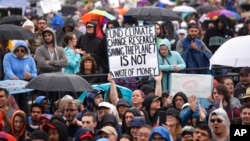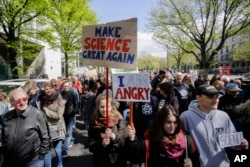After an unprecedented global rally in support of science-based policymaking, organizers of last Saturday's March for Science say the real measure of success will be whether they can translate the event's enthusiasm into action.
After crowds rallied in Washington and more than 600 other locations around the world April 22, march planners now urge those who participated to go out into their communities and advocate for science.
"WE MARCHED. NOW, WE ACT," reads the updated March for Science website, which lays out It lays out a week of action. Suggestions for Monday target local engagement: Start science game nights or book clubs, for example. Tuesday calls for contacting policymakers on science issues.
The more than 260 groups that backed the march also are urging their members to stay engaged.
The American Geophysical Union (AGU), which represents 60,000 earth and space scientists, has five weeks of action planned, with a similar strategy: Write your representatives; speak in your community; organize.
Symptom
As a scientist-led movement, the March for Science is unprecedented in its size and reach. It is a symptom of the concern that has been building in the scientific community. Scientists say ideology has overtaken evidence as the basis for policy on climate change, vaccines and much more.
"Certainly, though, recent political events in the U.S. and around the world have heightened that incentive" to mobilize, said AGU Executive Director Chris McEntee. "So, we are seeing larger and larger numbers of our members who want to participate."
Others are seeing the same thing. The union representing Department of Energy employees says membership has grown 30 percent in the last four months. Advocacy group Union of Concerned Scientists (UCS) has added about 3,000 members to its network of scientists, engineers, economists and other experts. The science network now tops 20,000.
"There's just a lot of energy out there," said Andrew Rosenberg, director of the UCS Center for Science and Democracy. "People want to know what they can do. And many, many people in the science community realize that retreating to your lab and hoping things go OK is just not sufficient in the current climate."
Some have decided it's time they step into the political arena. About 5,000 scientists have announced plans to run for office since the beginning of this year, according to 314 Action, an advocacy group that champions scientists seeking elected office.
"That is five times more than our most optimistic projection," said Shaughnessy Naughton, who founded 314 Action after an unsuccessful run for Congress in 2016.
Scientists have felt under attack since before the Trump administration, she said. But Trump's hostility to climate science "certainly has been a catalyst for getting more scientists to say, 'Enough. I can't just write another polite letter. I need to step up and get more involved.'"









